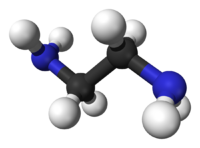Ethylenediamine
| Ethylenediamine | |
|---|---|
 |
|
 |
|
|
1,2-diaminoethane
|
|
|
Other names
en; ethane-1,2-diamine; Edamine[1]
|
|
| Identifiers | |
| CAS number | 107-15-3 |
| UN number | 1604 |
| RTECS number | KH8575000 |
|
SMILES
NCCN
|
|
| Properties | |
| Molecular formula | C2H8N2 |
| Molar mass | 60.103 g/mol |
| Appearance | colourless liquid (impure: yellow) |
| Density | 0.899 g/cm3, liquid |
| Melting point |
9 °C |
| Boiling point |
116 °C |
| Solubility in water | Miscible in water |
| Solubility | Most polar solvents |
| Basicity (pKb) | 3.92 |
| Structure | |
| Molecular shape | Tetrahedral at N and C |
| Hazards | |
| Main hazards | Flammable, corrosive |
| Related compounds | |
| Related polyamines | Diethylenetriamine Triethylenetetramine Polyethylene amine Tetramethylethylenediamine |
| Related compounds | Ethanolamine |
| Except where noted otherwise, data are given for materials in their standard state (at 25 °C, 100 kPa) |
|
| Infobox references | |
Ethylenediamine (abbreviated as en when a ligand) is the organic compound with the formula C2H4(NH2)2. This colorless liquid with an ammonia-like odor is a strongly basic amine. It is a widely used building block in chemical synthesis, with approximately 500,000,000 kg being produced in 1998.[2]
Contents |
Synthesis
Ethylenediamine is manufactured by reacting ammonia and 1,2-dichloroethane. The reaction yields the mixture of ethylenediamine and the linear polyamines. A simplified equation would be:
-
- ClCH2CH2Cl + 4 NH3 → H2NCH2CH2NH2 + 2 NH4Cl
Applications
Ethylenediamine is used in large quantities for production of many industrial chemicals. It forms derivatives with carboxylic acids (including fatty acids), nitriles, alcohols (at elevated temperatures), alkylating agents, carbon disulfide, and aldehydes and ketones. Because of its bifunctional nature, having two amines, it readily forms heterocycles such as imidazolidines. Ethylenediamine is a well-known chelating ligand for coordination compounds, such as [Co(ethylenediamine)3]3+.
Precursor to chelating agents
The most prominent derivative of ethylenediamine is EDTA, which is derived from ethylenediamine via a Strecker synthesis involving cyanide and formaldehyde. Hydroxyethylethylenediamine is another commercially significant chelating agent. The salen ligands, derived from the condensation of salicylaldehydes and ethylenediamine, are popular chelating agents in the research laboratory although not commercially significant.[2]
Precursor to pharmaceuticals and agrichemicals
Numerous bio-active compounds contain the N-CH2-CH2-N linkage, including aminophylline and some antihistamines.[3] Salts of ethylenebisdithiocarbamate are commercially significant fungicides under the brandnames Maneb, Mancozeb, Zineb, and Metiram. Some imidazoline-containing fungicides are derived from ethylenediamine.[2]
Role in polymers
Ethylenediamine, by virtue of its bifunctionality (i.e. it contains two reactive amines) is widely used in diverse polyester formulations. Condensates derived from formaldehyde are plasticizers. It is widely used in the production of polyurethane fibers. The PAMAM class of dendrimers are derived from ethylenediamine.[2]
Tetraacetylethylenediamine
The bleaching activator tetraacetylethylenediamine is generated from ethylenediamine. The derivative N,N-ethylenebis(stearamide) (EBS) is a commercially significant mold-release agent and a surfactant in gasoline and motor oil.
Specialized applications
- as a solvent, it is miscible with polar solvents and is used to solubilize proteins such as albumins and casein. It is also used in certain electroplating baths
- as a corrosion inhibitor in paints and coolants.
- ethylenediamine dihydroiodide (EDDI) is added to animal feeds as a source of iodide.
- chemicals for color photography developing, binders, adhesives, fabric softeners, curing agents for epoxys, and dyes.
- Ethylenediamine (Edamine) is a common organic additive to the plant in vitro culture Murashige and Skoog medium.
Ethylenamines
Ethylenediamine is the first member of the so-called polyethylene amines, other members being:
- Diethylenetriamine, abbreviated dien or DETA, (H2N-CH2CH2-NH-CH2CH2-NH2, an analog of diethylene glycol)
- Triethylenetetramine, abbreviated trien or TETA, (H2N-CH2CH2-NH-CH2CH2-NH-CH2CH2-NH2)
- Tetraethylenepentamine, abbreviated TEPA, (H2N-CH2CH2-NH-CH2CH2-NH-CH2CH2-NH-CH2CH2-NH2),
- Pentaethylenehexamine, abbreviated PEHA, (H2N-CH2CH2-NH-CH2CH2-NH-CH2CH2-NH-CH2CH2-NH-CH2CH2-NH2), up to polyethylene amine. Similarly piperazine is an analogue of dioxane.
Related diamines
In terms of quantities produced, ethylenediamine is the most significant diamine (aside from diaminohexane, which is a precursor to Nylon 6-6). Related derivatives of ethylenediamine include tetramethylethylenediamine, abbreviated (TMEDA), (CH3)2N-CH2CH2-N(CH3)2 and tetraethylethylenediamine, abbreviated (TEEDA), (C2H5)2N-CH2CH2-N(C2H5)2
Safety
Ethylenediamine exposure can cause the skin to become irritated. It was used in commercially available skin products including Mycolog cream.[4] Ethylenediamine has a half-life of about 30 minutes and a small volume of distribution of 0.133 liters/kg. After oral administration its bioavailability is about 0.34, due to a substantial first-pass effect. Less than 20% is eliminated by renal excretion.[5]
References
- ↑ http://eur-lex.europa.eu/smartapi/cgi/sga_doc?smartapi!celexplus!prod!DocNumber&lg=fr&type_doc=Regulation&an_doc=2007&nu_doc=129
- ↑ 2.0 2.1 2.2 2.3 Karsten Eller, Erhard Henkes, Roland Rossbacher, Hartmut Höke "Amines, Aliphatic" in Ullmann's Encyclopedia of Industrial Chemistry, 2005 Wiley-VCH Verlag, Weinheim.
- ↑ Kotti, S. R. S. S.; Timmons, C. and Li, G. (2006). "Vicinal diamino functionalities as privileged structural elements in biologically active compounds and exploitation of their synthetic chemistry". Chemical Biology & Drug Design 67: 101–114. doi:10.1111/j.1747-0285.2006.00347.x.
- ↑ Hogan DJ. (January 1990). "Allergic contact dermatitis to ethylenediamine. A continuing problem.". Dermatol Clin. 8 (1): 133–6. PMID 2137392.
- ↑ Zuidema J. (1985-08-23). "Ethylenediamine, profile of a sensitizing excipient.". Pharmacy World & Science 7 (4): 134–40. doi:10.1007/BF02097249. PMID 3900925.
External links
|
||||||||||||||